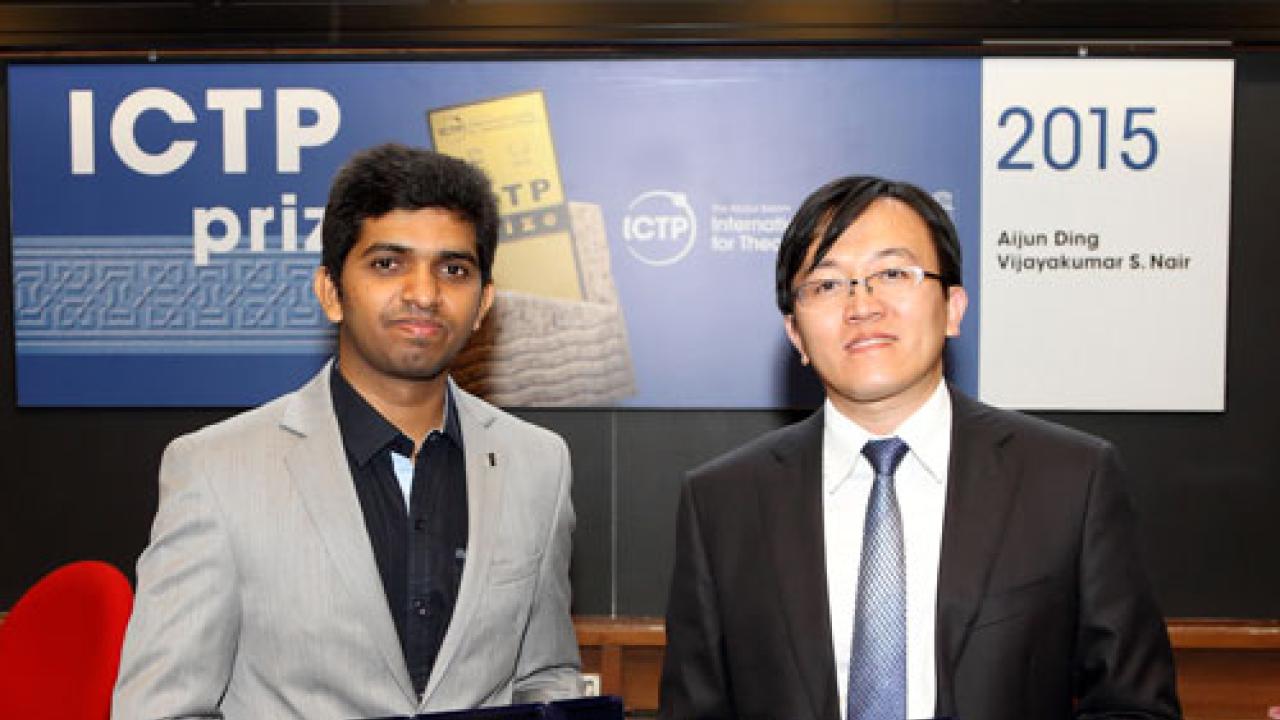
The 2015 ICTP Prize was presented recently during a ceremony at ICTP to Aijun Ding and Vijayakumar S. Nair, two scientists independently researching the atmospheric chemistry and physics of air pollution as well as its complex interactions with climate. Nair, a junior scientist at the Space Physics Laboratory of the Vikram Sarabhai Space Centre, Kerala, India, and Ding, a Professor at the School of Atmospheric Science, Nanjing University, China, investigate how aerosols affect local, regional, and global climate and weather patterns. Their studies combine new observations with modeling insights on the interactions between pollution, natural aerosols, and climate patterns, a key step toward understanding how aerosols affect climate and how anthropogenic aerosols contribute to climate change uncertainties.
India and China are currently dealing with significant levels of air pollution, and recent research indicates that air pollution has effects beyond poor visibility and health issues for the local population. Nair and Ding discussed some of those effects at the ICTP Prize ceremony, where the two young, accomplished scientists presented their respective research to the ICTP community. The lectures reflected the multiple-region scope of their research as well as a shared concern for how aerosols, or fine particles suspended in the atmosphere, affect climate patterns. "Atmospheric aerosols and clouds contribute significantly to the uncertainty in climate projections," says Nair. These uncertainties manifest in a variety of different ways. Different types of aerosols can affect local temperature variation, as well as strongly influence local weather patterns, affecting how much rain falls and when.
Rainfall is important: the Indian summer monsoon plays a big role in supporting more than a billion people living in South Asia. Over the last decade those rains have been intensifying over southern India, disrupting agriculture and causing floods. Climate scientists have previously linked stronger monsoons to the amount of dust in the atmosphere coming from the Middle East, which, for unknown reasons, has also been increasing in recent years. This link is one of the effects of aerosols that Nair investigates, and his research supports that link, finding that a larger amount of dust in the atmosphere was indeed acting as a positive feedback mechanism and driving more rain over southern India. "Aerosols have significant impacts on intra-seasonal to decadal variations of rainfall over the region," Nair says, explaining that this research is a key step toward understanding how aerosols affect climate and how anthropogenic aerosols contribute to climate change uncertainties.
One of Ding's research topics discussed during the ceremony covers how a particular aerosol, the human-made, light-absorbing black carbon, affects local weather patterns. In fact, his recent work has found that black carbon aerosols greatly enhance air pollution in megacities. One mechanism for this is Ding's recently described 'dome effect', where black carbon in the troposphere, the atmospheric layer that humans live in, is a barrier that prevents solar energy from warming the surface of the Earth, but lets it efficiently heat the upper atmosphere. Both of these factors make the atmosphere's planetary boundary layer less likely to mix and bring fresh air in, which means all air pollution gets trapped in this 'dome' around a city. Ding and his colleagues' observations and modeling led to a recommendation for policies to specifically curb black carbon air pollution, not just focus on general aerosol levels, which could have a similarly outsize effect on improving air quality in megacities. "Aerosols are the most important pollution species influencing human health and the climate system, so tropospheric pollution is a challenge topic for atmospheric scientists," says Ding. "I like challenges."
The ICTP Prize is awarded every year to young (under 40) scientists from developing countries who also live and work in those countries, and have made outstanding contributions to physics or mathematics.
--Kelsey Calhoun













